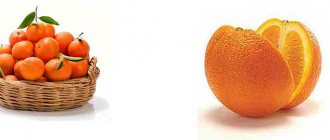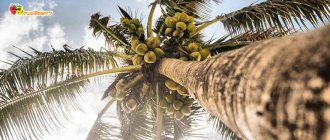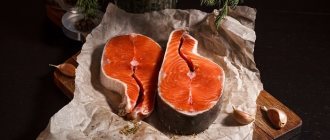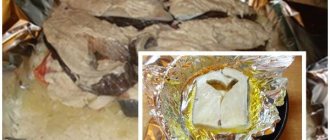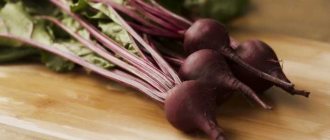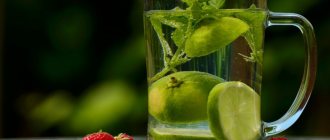- 16.05.2018
- GIFs, Health, Nutrition, Articles, Explanatory
Mango is a fruit that is yellow, red, orange or green in color and the flesh is yellow or orange in color. The taste is sweet and sour, reminiscent of a combination of pineapple and peach with a pine aroma. This fruit is called the “Ruler of Fruits” because it is the most popular fruit on the planet. The leader in mango cultivation is India, where more than 13,500 tons of this fruit are harvested annually. Let's figure out why mangoes are so popular, what benefits and harms the fruits have for the body, what composition and calorie content they have.
Botanical characteristics
Today there are over 2,000 different varieties of mangoes. They are conventionally divided into 2 types: Indo-Chinese (greenish and elongated fruit), Indian (orange-yellow and round). In addition, intervarietal hybrids are known - Indo-Chinese.
The most popular crops suitable for growing in a small garden or in a container on the balcony include the following crops:
- Cogshall;
- "Carrie"
- "Fairchild"
- "Ice Cream";
- "Julie"
- Lancettila;
- "Brooks";
- Mallika;
- "Okrung"
- "Neelum"
The weight of a ripe mango fruit is 200 - 300 grams, and the diameter depends on the plant variety and varies from 10 to 20 centimeters. The fruit tastes vaguely like a peach. The color of the skin depends on the variety and can be yellow-green, deep orange, pink, red, purple.
Mango is an evergreen tree of the tropics that reaches 20 meters in height. This is one of the most durable fruit species. The number of flowers in inflorescences reaches up to 4000 pieces. However, their binding rate is extremely low. A maximum of 2 fruits ripen in one inflorescence.
If the fruit is excessively sour, it is spoiled; if it is tasteless, it is unripe. Ripe fresh mango is sweet, fleshy and juicy, smooth to the touch, elastic with a shiny surface. The presence of dents, defects, or damage indicates that the product has begun to deteriorate.
Small black spots, on the contrary, indicate the ripeness of the fruit.
Wrinkled skin is a sign of stale fruit. If the surface of the mango is wet, then the juice is seeping out. This indicates that the fruit is damaged internally.
When pressed, the peel of a ripe mango springs back and crushes under your fingers. After light pressure, it should restore its original shape. The smell of fresh ripe fruits is sweetish, resinous, coniferous, and is strongly manifested at the stalk. If the mango does not smell, it means it is not yet ripe; it exudes an intense aroma - it is overripe.
The shape of the mango depends on the type of tree and can be elongated-ovoid, spherical, pear-shaped, ovoid. In the center of the fruit there is an inedible, large and heavy seed, 10 centimeters long and weighing 50 grams. The outside of the bone is covered with a protective shell.
Chemical composition
Mango is the most important fruit of the tropics, which in India is called the “fruit of the gods.” Its chemical composition depends on the crop variety and stage of ripening. Green fruits contain a lot of starch, which as the fruit grows turns into simple carbohydrates: maltose, glucose, sucrose.
Unripe mango is a storehouse of pectin.
With the formation of a hard bone, its quantity decreases by more than 2 times. 15 milligrams of green fruit pulp contains the same amount of ascorbic acid as is concentrated in 30 milligrams of lime. At the same time, the presence of malic, succinic, citric, and oxalic organic acids gives the fruit a characteristic, very sour taste. Ripe fruit, on the contrary, is sweet and pleasant to the taste. It contains a lot of sugars, vitamins (A, , C, E, K, PP) and few acids. Table No. 1 “Nutritional value of mango”
| Components | Contents per 100 grams of product |
| Calorie content | 65 calories |
| Water | 83.46 grams |
| Carbohydrates | 15.2 grams |
| Mono- and disaccharides | 13.66 grams |
| Sucrose | 6.97 grams |
| Fructose | 4.68 grams |
| Glucose | 2.01 grams |
| Alimentary fiber | 1.6 grams |
| Squirrels | 0.5 grams |
| Essential amino acids (glycine, glutamic, aspartic acid, alanine, tyrosine, serine, proline) | 0.36 grams |
| Ash | 0.36 grams |
| Essential amino acids (isoleucine, leucine, lysine, arginine, valine, histidine, phenylalanine, methionine, threonine, tryptophan) | 0.316 grams |
| Fats | 0.25 grams |
| Saturated fatty acids (stearic, lauric, myristic, palmitic) | 0.182 grams |
| Omega-9 | 0.075 grams |
| Omega-3 | 0.051 grams |
| Omega-6 | 0.019 grams |
Table No. 2 “Chemical composition of mango”
| Name | Nutrient content per 100 grams of product, milligrams |
| Vitamins | |
| Ascorbic acid (C) | 36,4 |
| Pantothenic acid (B5) | 0,197 |
| Tocopherol (E) | 0,9 |
| Riboflavin (B2) | 0,038 |
| Niacin (B3) | 0,669 |
| Thiamine (B1) | 0,028 |
| Beta-carotene (A) | 0,054 |
| Choline (B4) | 7,6 |
| Pyridoxine (B6) | 0,119 |
| Phylloquinone (K) | 0,0042 |
| Folic acid (B9) | 0,043 |
| Macronutrients | |
| Potassium | 165 |
| Phosphorus | 14 |
| Calcium | 11 |
| Magnesium | 10 |
| Sodium | 1 |
| Microelements | |
| Iron | 0,16 |
| Copper | 0,111 |
| Zinc | 0,09 |
| Manganese | 0,063 |
| Selenium | 0,0006 |
A plant tranquilizer was found in the leaves of the mango tree, and tannins were found in the pulp and skin of the fruit.
Dishes
Ripe mango is incredibly aromatic and tasty. There is only one problem - peeling the fruit is not easy. There are special devices on sale that make the process easier. If there are none, it is advisable to follow the following recommendations:
- cut the fruit on both sides, trying to cut through to the pit;
- take it in both hands and rotate the halves in a cross-shaped motion.
One half separates from the pit easily. The second remains with a bone that needs to be removed with a knife. If the mango is not ripe enough and has a dense peel, it is carefully cut off with a sharp knife. The pulp is then cut into slices, thus “exposing” the bone. The ready-to-eat pulp can be used to prepare many low to medium calorie dishes.
Juice
Mango juice is obtained by squeezing the fruit. A regular juicer is used. In cooking, the juice is used to make desserts, jelly, baked goods and fresh salads. Cocktails are often prepared based on it. The juice is also mixed with milk to create a refreshing drink. The calorie content of the shake is 35 kcal per 100 g.
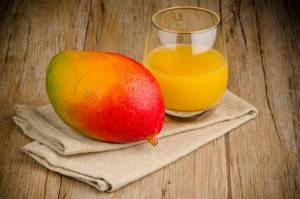
Fruit juice is not only tasty, but also extremely healthy. Its chemical composition contains B vitamins, vitamins C, E and D. The mineral composition is represented by magnesium, potassium, calcium, and phosphorus. It also contains 12 amino acids. Drinking juice naturally has beneficial effects on the body:
- helps with diseases of the organs of vision;
- increases resistance to pathogens and improves immunity;
- stabilizes the functioning of the digestive tract;
- normalizes the condition with a tendency to cardiovascular diseases.
The calorie content of 100 g of mango juice is 57 kcal, so it can be consumed during weight loss.
Lassi
India is also the birthplace of this unusual drink. It consists of yogurt, water, spices and fruit. The Russians slightly modified the original recipe, replacing yogurt with pineapple and adding nuts.
To prepare lassi, you need the most ripe fruits of an exotic plant in the amount of 250 g. You also need 100 g of pineapple, 150 ml of water and 50 g of cashew nuts. The calorie content of the drink per 100 g is 93 kcal, that is, you should not abuse it on a diet.
To begin, soak the cashews in water for 20 minutes. The fruits are peeled and cut into small pieces. Place all ingredients in a blender bowl and beat until foam forms.
Smoothie
A smoothie based on mango and spinach is the right solution for those losing weight, because along with the speed of preparation and the supply of vitamins, it has a big advantage in the form of satiety. They can easily replace breakfast or drink for dinner, receiving only 51 kcal for every 100 g.
Place 150 g of spinach (you can take either fresh or frozen), half a mango, half a banana into a blender bowl. Add half a glass of natural yogurt and low-fat milk. Beat the ingredients until smooth. If the finished smoothie is too thick, you can always dilute it with water or milk.
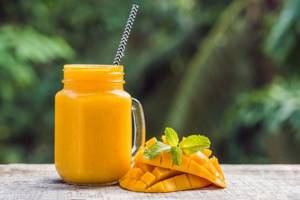
Puree
Mango puree is a natural exotic dessert, the calorie content of 100 grams is 60 kcal. It is quite acceptable for a dietary diet, so puree can be used as an alternative to unhealthy sweets. You can prepare puree at home in several ways:
- The juicy pulp of the Asian apple is cut into small pieces and pureed in a blender bowl. The puree is simmered on the stove for several minutes. You can add sugar, but to maintain a low calorie content, it is better to avoid it. It is noteworthy that after heat treatment the puree does not change color, remaining attractively yellow.
- The mango is cut into slices without removing the skin. Bake in the oven for 20-30 minutes. Separate the baked pulp from the skin and grind in a blender. This method does not require additional heat treatment of the puree.
In cooking, mango puree can be used not only as an independent dessert, but also as a flavorful addition to dietary pancakes, casserole, and yogurt.
In addition to the unusual taste, puree demonstrates benefits for the body. With its help, it is possible to establish the digestion process, strengthen the heart and blood vessels, and prevent inflammatory processes in the oral cavity.
Salad with avocado
A light, refreshing salad with vegetables and mango - an ideal dish for a morning meal or evening snack. 100 grams contain 45 kcal, that is, the salad can be considered as low-calorie and dietary as possible.
To prepare, take 140 grams of fresh cucumber cut into rings, 50 grams of avocado chopped into small squares, 160 grams of chopped tomatoes, 100 grams of mango cut into pieces. The ingredients are mixed and sprinkled with lemon juice. When serving, sprinkle with chopped herbs and, if desired, sesame seeds. However, the last component is not included in the total calorie content, which should be taken into account when dieting.

Salad with celery
The salad using the juicy pulp of exotic fruits and the stems of the famous fat burner turns out bright and healthy. There is also no doubt about its lightness and low calorie content - only 52 kcal per 100 g.
To prepare a serving of salad, you need to tear 25 g of lettuce leaves, chop 35 g of stem celery, 40 g of bell pepper and 130 g of exotic pulp. All ingredients are laid out on a plate in a chaotic order, after which they are sprinkled with a pinch of pomegranate and sesame seeds. No dressing is required for this mix, since the juiciness comes from the mango pulp.
Since the calorie content of the dish is low, this salad can be eaten both for lunch and instead of dinner.
Salad with egg
More satisfying, but at the same time more high-calorie - salad with mango and egg. There are 111 kcal per 100 g. The salad contains a not very “healthy” ingredient - mayonnaise. If the dish is used during a period of weight loss, it is better to replace the store-bought one prepared with your own hands. There is a way to reduce calories - use lemon juice or olive oil instead of mayonnaise.
Since the salad can be stored for several days (in the absence of mayonnaise) and eaten several times a day, you can prepare several servings at once. First, 100 g of iceberg lettuce is cut into small pieces and placed on a dish, after which 80 g of the juicy pulp of the exotic fruit is chopped into cubes. Also spread in a layer on the iceberg. The next step is chopping a fresh cucumber, which is placed on top. Next comes the tomato. He is also chopped. Lubricate with a small amount of mayonnaise. Boil 2 hard-boiled eggs, grate them on a fine grater and place them on top of the mayonnaise. After even distribution, grease with mayonnaise again. Fresh tomato is used for decoration. The salad can also be sprinkled with chopped herbs.
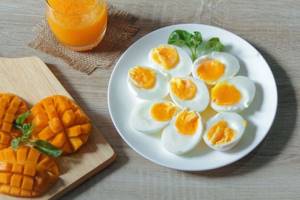
Quick dessert
The dessert is prepared very quickly - up to 15 minutes. The only condition is the presence of a ready-made biscuit. Looks like a good alternative to unhealthy sweets. There are 125 kcal per 100 g, which makes it lower in calories compared to regular cakes and sweets. If we take into account proteins, fats, carbohydrates, then a larger percentage falls on the latter. This means that it is undesirable to overindulge in dessert in the evening, especially when trying to lose weight.
To prepare dessert you need a glass. Place a piece of biscuit on the bottom. Place some strawberries on top (five pieces are enough) and a handful of juicy mango pulp. The remaining pulp and another whole fruit are cut into small pieces. Place in a blender bowl and add a whole banana. The fruit is turned into puree, to which freshly squeezed juice of half an orange is added. The finished mass is transferred into a glass.
Beneficial features
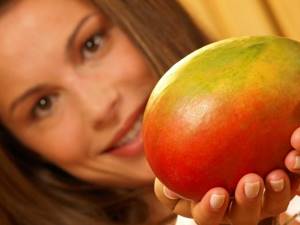
The exotic fruit has long been used in Asian medicine to treat cholera and plague. Today, the fruits of the mango tree are used as a hemostatic, diuretic, and antioxidant agent. In addition, they are used to eliminate heartburn and treat acute dermatitis.
In order to cleanse the body of toxins and lose weight, mangoes are consumed with milk. A successful combination of proteins and sugars gives a feeling of satiety, lightness and creates an optimal balance of these compounds in the body.
Ripe, aromatic, sweet fruits with a slight sourness are eaten. When purchasing green fruit, leave it in a dark, warm place to allow it to mature. If a mango is placed in the refrigerator, the fruit will soften and lose its taste and beneficial properties.
The effect of Asian apple on the human body:
- improves vision;
- normalizes digestion, fights heartburn;
- strengthens the immune system;
- protects against sunstroke;
- supports brain function;
- relieves pain;
- restores strength;
- reduces fever;
- relieves inflammation, is used to treat gum diseases (periodontal disease, stomatitis);
- improves mood;
- normalizes sleep;
- increases stress resistance, relieves tension;
- strengthens blood vessels, heart;
- normalizes metabolism;
- prevents the growth of malignant neoplasms of the colon, stomach, mammary, prostate, and pancreas;
- improves bile flow;
- relieves fatigue;
- increases sexual activity;
- thins mucus;
- reduces the manifestations of varicose veins;
- cleanses the intestinal walls of harmful substances.
Mangoes are of particular value to women during pregnancy and lactation. The exotic fruit softens the symptoms of toxicosis, maintains normal hemoglobin levels, and relieves heartburn and constipation.
Mango fruits help restore the female body after childbirth.
During breastfeeding, the fruit is consumed with caution, observing the baby's reaction to the product. If the baby refuses to take milk, is capricious, or redness appears on his body, exclude mangoes from the diet of the young mother. From 8 months, introduce the fruit into your child’s menu in the form of puree or freshly squeezed juice.
To avoid bloating, the fruit is given in small doses (5 grams) at first, then the amount is gradually increased.
To relieve heart pain, hold a piece of mango on the tip of the tongue for 6–7 minutes, and to strengthen the walls of blood vessels, drink a decoction of dried leaves. Traditional healers in India use the seeds of the fruit to treat asthma, the juice of the fruit treats acute dermatitis, and with a mixture of Asian apple pulp, honey and pepper, they remove toxins from the liver and improve the flow of bile.
Unripe mango fruits dried in the sun contain up to 50 milligrams of vitamin C (per 100 grams) and are an indispensable remedy for the prevention of winter hypovitaminosis.
Fresh
A fruit from India is something special. Its taste is represented by a mix of apple sourness, orange freshness and honey melon sweetness. The fruits are oval and heavy, weighing on average 300-350 grams. The color of the peel can be red-green, red, green or brownish. There are also almost black fruits. The color of the skin depends on the variety of mango, and there are about 300 of them (Indian is the most familiar to Russians, since it is sold in any supermarket). The pulp, in any case, is dense and juicy, colored bright orange or dark yellow. A distinctive feature is long fibers, which are sometimes hard. The fruit has a large stone that is difficult to separate from the pulp.
A special type is the Thai mango in the shape of an oblong oval, the skin of which is bright yellow. The pulp is juicier than Indian, so when you bite the juice literally flows down your hands. The texture is oily and, unlike its Indian counterpart, not at all fibrous. The taste of the Thai fruit is somewhat different from the Indian one, because it seems somewhat “sticky” vanilla-peach. The calorie content of the yellow product is 70 kcal per 100 g.
Mango color is due to its high carotene content. It is noteworthy that there are much more carotenoids in ripe fruit than in tangerines.
Amazing taste is not the only advantage of mango, but only one of many. The fruits contain a record amount of useful substances. In particular, the composition contains all kinds of vitamins, such as A, C, E, mineral salts of calcium, phosphorus and iron. Contains fruit and essential amino acids. Since the human body is not capable of producing these on its own, eating an Asian apple seems to be a good opportunity to replenish reserves.
Traditional medicine has appreciated the importance of mango as a food product for a long time. From the point of view of doctors, its ability to prevent cancer of various organs is seen as unique. The fruit is useful for the reproductive and genitourinary systems, especially for women. It is not without reason that this exotic product is considered a good stress reliever. According to research, it relieves mental and nervous tension, improves mood and overall well-being. Mango is extremely beneficial for the cardiovascular system, as it improves blood clotting. In general, eating an Asian apple allows you to:
- prevent constipation and stagnation of bile in the body;
- improve digestion, normalize the functioning of the intestines and stomach;
- strengthen vision;
- improve memory;
- reduce the level of nervous excitability and improve sleep;
- improve the condition of diabetes;
- cure anemia;
- increase immunity;
- strengthen muscles.
On top of that, mango has a mild laxative and diuretic effect, that is, it cleanses the body of waste and toxins. With a low calorie content - 67 kcal per 100 grams - this seems to be an excellent choice for tasty weight loss. By the way, in comparison with other fruits allowed in diets, mangoes are not endowed with a very high calorie content (for example, 100 g of apple contains 48 kilocalories). In addition, as much as 80% of the fruits of the exotic plant consist of water. The glycemic index of the fresh product is 55 units, that is, classified as average, which is another argument in favor of eating mango in a diet.
The low-calorie Asian apple contains plant fiber, which not only normalizes the functioning of the digestive tract, but also eliminates appetite for a long time. The satiety of mango is very appropriate when on a diet. It is enough to treat yourself to a piece of fruit, and in the near future those who are losing weight will be protected from the desire to snack. And since the fruits are also sweet, there is a natural rejection of harmful sweets.
The average weight of 1 piece of mango is 350 g. The calorie content of such fruit is estimated at 234 kcal. At first glance, it seems like a lot, but consuming the whole fruit will help you get rid of your appetite for at least 6 hours!
Mangoes are most often consumed fresh. This is a wonderful dessert that does not require any additions and delivers incomparable pleasure. The exotic fruit is no less beautiful when used in fruit salads and smoothies, which do not change its calorie content. However, it is worth knowing that the aromatic Asian apple helps better digestion of heavy foods, so it is recommended to be served along with meat dishes.
Important! Mango is a suitable product for losing weight because it does not contain many calories and protein. However, the absence of proteins means a lack of strength and energy, so it is better to eat fruit on a diet with milk. By combining two products, you can lose several kilograms in a few days without harm to your health.
When choosing fruit in a store, you need to follow several rules. First, you need to check the smoothness of the skin and its shine, and also evaluate its elasticity when pressed. Secondly, it is important to evaluate the smell emanating from an Asian apple: it should be strong fruity, sometimes a little pine or even turpentine. If there is no aroma, then the fruit is not fully ripe. Nothing wrong with that. You can “bring” mangoes to maturity at home by wrapping them in thick paper and leaving them in a dark place for several days. If the fruit is completely ready to eat, it should be stored in the refrigerator. Under the right conditions, it will be possible to maintain freshness for several weeks. The cut fruit should also be kept in the refrigerator, but no more than two days. In the future, the mango completely loses its taste.
Before eating, you need to remove the fruit from the refrigerator and wait until it warms up. Otherwise, you may not feel its aroma. The benefit will also be slightly reduced.
Anti-cancer properties
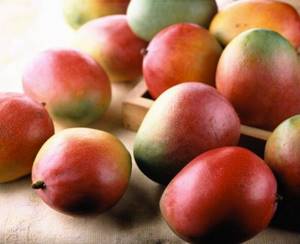
According to research by scientists from the University of Texas, mangoes are an effective remedy for preventing breast cancer. The power of tropical fruit is in polyphenols. Antioxidants from plant foods exhibit anti-inflammatory properties and help reduce oxidative stress, which leads to the development of chronic diseases and the growth of malignant tumors. In addition, mangoes contain flavonoids, carotenoids, and phenolic compounds that suppress harmful bacterial environments.
Polyphenols are involved in the inhibition of growth, proliferation, and destruction of modified breast cells. It has been experimentally established that with the introduction of 5 μg/ml GAE of natural antioxidants, the division of malignant cells is reduced by 90%, and of non-cancerous cells by 20%. Thus, mango polyphenols are specific to modified body tissue. In addition, the exotic fruit reduces the expression of microRNA-21, a short molecule of microribonucleic acids associated with cancer, and has anti-inflammatory activity.
In experiments conducted on mice, scientists discovered that tropical polyphenols reduce the expression of a regulatory protein that affects cellular oxygen uptake. The fight against cancer is the potential of mango plant antioxidants, which is currently under detailed study.
Product selection rules
When choosing a dried fruit, you need to pay attention to its color. It should not be bright orange or yellow. To give a bright color, SO2 is usually used. This substance is designated as E220 on the packaging. It also increases shelf life. However, it is a highly toxic compound.
Penetrating inside the body, the substance creates discomfort in the respiratory tract, causing cough, runny nose and migraine. Because of this, it is best to choose fruit that is pale yellow or natural in color.
Dried fruit should be stored away from products with a strong odor in a ventilated and dark room at a temperature of 0-22°C. A glass jar, paper bag or plastic container is suitable for storage. The product in hermetically sealed packaging can be placed in the refrigerator.
Bright dried mango can be beneficial or harmful to the body. If you consume the fruit in moderation, there will be no health problems. The body will be saturated with nutrients.
Contraindications
The skin of the tropical Asian apple can become an allergen, but the fruit itself can be eaten. Therefore, it is recommended to use gloves when peeling the fruit. Ripe mango pulp in large quantities causes fever, hives, constipation, clogs the stomach, and disrupts the functioning of the digestive tract.
When overeating green fruits, a person experiences discomfort in the epigastric region due to irritation of the mucous membrane of the respiratory tract, throat and stomach. Colic and indigestion may occur.
Dried
Dried (dried) mango is in no way inferior to fresh mango in popularity. Dried fruits made from the pulp of an aromatic product have long been widely used in the culinary industry. They are tasty and healthy, as the residents of Thailand know for sure. The latter use dried mango everywhere, adding a delicate aroma and pleasant taste to their dishes. And, of course, such dried fruits are a nutritious and healthy snack, even despite their rather high calorie content.
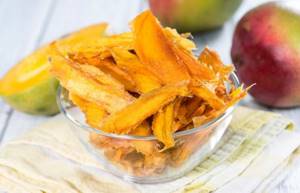
The calorie content of the product is 314 kcal per 100 grams, and the calorie content of candied mango, which can also be classified as dried fruit, is 287 kcal per 100 g. Compared to a fresh product, this is a lot, so those losing weight should include dried fruits in their diet carefully.
Despite their high calorie content, candied and dried mango fruits are a complete and completely harmless snack.
Taste is not the only reason to buy a product. In fact, dried fruits contain many vitamins, including group B, the beneficial properties of which have been studied for a long time, and 12 types of amino acids. In addition, fruit slices contain fructose, phosphorus, calcium, etc. It is not surprising that eating aromatic dried fruits helps normalize the digestive tract and improve metabolism, protect against diseases of the cardiovascular system and prevent anemia. The dried product is also rich in fiber, which cleanses the body of harmful accumulations. Additionally, regular consumption of dried product allows us to talk about the following benefits:
- stabilization of the nervous system;
- normalization of sleep;
- increasing immunity;
- improvement of blood composition;
- rejuvenation of the body.
Important! Most of the calories in dried mango come from carbohydrates. However, the absence of cholesterol in it seems to be a big plus for inclusion in the diet.
Commercially, dried mango is made from ripe pulp, which is cut into thin strips and placed in a dehydrator to remove moisture. The finished product is coated with a thin layer of rice oil to preserve its beneficial qualities and attractiveness. You can prepare a healthy product yourself. First, the pulp is cut into thin slices, after which it is blanched in sugar syrup. It is noteworthy that the use of syrup significantly increases the calorie content, so for the diet it is better to use the blanching method in boiling water without adding sugar. The second stage of preparing dried fruits is drying itself. You can use an oven or electric dryer (temperature 60 degrees), and also expose the product to natural drying in the fresh air. In the latter case, the pulp can be either laid out on parchment or strung on a thread, making a kind of “garlands”.
Dried mango is consumed separately as a snack and added to various dishes: fruit salads and muesli (acts as a natural sugar substitute), baked goods. A great idea is tea with aromatic dried fruit. Since no more than two small pieces are needed for preparation, the calorie content of the drink will not be high.
Application in cosmetology
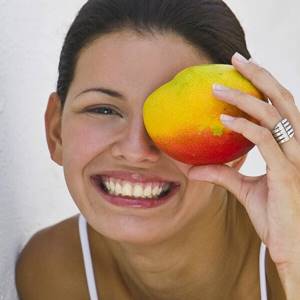
Mango is a source of vitamins (A, B, C, E, K), minerals (potassium, phosphorus, calcium, magnesium), saturated fatty acids (oleic, stearic, palmitic, arachidic, linoleic), which are essential for maintaining youthful and beautiful skin , hair Thanks to its balanced composition, the fruit protects the dermis from the aggressive effects of low temperatures, wind, and ultraviolet radiation.
Asian apple extract or oil:
- moisturizes, nourishes, refreshes the skin;
- normalizes metabolic processes in tissues;
- relieves itching;
- eliminates irritation, dryness, peeling;
- fights pigmentation;
- restores the lipid barrier;
- prevents the appearance of stretch marks;
- softens rough areas;
- smoothes hair fiber scales;
- neutralizes the effects of free radicals;
- promotes moisture retention after sun treatments;
- evens out facial tone;
- returns softness, firmness, elasticity to the dermis;
- protects cell membranes from premature destruction;
- promotes skin regeneration;
- accelerates the healing of microtraumas, wounds, cracks.
Mangoes are used for the production of anti-aging, medicinal, sunscreen cosmetics, hair, scalp, face, and body care products.
The secret of a tropical fruit mask
The vitamins, macro- and microelements that make up mango nourish the dermis and solve the following issues:
- ascorbic acid – rejuvenates;
- retinol – relieves inflammation, moisturizes;
- choline – calms;
- folic acid – protects against harmful effects;
- tocopherol – tones, fights acne, acne.
Mango mask is beneficial for the following skin types:
- oily (regulates the functioning of the sebaceous glands);
- dry (moisturizes);
- sensitive (forms a protective shell);
- fading (smoothes out wrinkles);
- problematic (relieves inflammation).
In order for the beneficial properties of mango to be fully manifested, use only soft, juicy, ripe fruits. Remember, the tropical fruit contains active, aggressive substances and acids, so before applying the mask to your face, check it for allergies. To do this, spread the mixture evenly onto the skin of the wrist and wait 15 minutes. If there is no redness, rash, burning or itching, the mask can be applied to the face.
The duration of stay of the product on the skin is 20 minutes. If the time limit is increased, the mango mask may cause an allergic reaction or lead to acid burns. To deeply nourish the dermis, it is recommended to perform the procedure once a week, improve the condition of problem skin or eliminate oily sheen from the T-shaped zone - two.
The mask is applied to cleansed facial skin, avoiding the area around the lips and eyes. Wash off with cool water.
Mango mask recipes

Rejuvenating. Grind the pulp of half a mango in a blender, mix the resulting puree with 15 grams of starch, 10 milliliters of olive oil. Mix the mixture thoroughly.- Cleansing. Grind the mango until mushy. Grind almonds and oatmeal into flour. Combine all ingredients in equal quantities, add thick cream 35%, cosmetic clay.
- Nutritious. Ingredients: 30 grams of mango pulp puree, 15 milliliters of olive or peach oil, 5 milliliters of bee honey.
- Anti-inflammatory. Mix half a mango puree with 50 milliliters of medium-fat kefir.
- For dry skin. Mix the crushed pulp of half a mango with 5 milliliters of chamomile or apricot oil, 15 grams of butter, and the yolk of one chicken egg.
- For the sensitive. Grind the mango pulp into a puree and apply it to your face.
- For oily skin. Beat the white of one chicken egg and puree the pulp of half a mango. Combine these ingredients, add 5 grams of bee honey.
- From blackheads. Mix mango pulp with olive oil until the consistency of thick sour cream.
- To improve facial tone. Boil one carrot, grate 50 grams. Grind a third of the mango pulp with a fork. Combine the ingredients, add 5 milliliters of chamomile oil, 60 milliliters of pre-melted natural honey.
- From wrinkles. Steam the oatmeal. Add mango juice and natural liquid honey to the porridge.
- To remove the stratum corneum. Method for preparing the scrub: mix 5 grams of almonds ground into powder with 5 milliliters of natural honey and the pulp of a quarter of a medium mango. Bring the mixture until smooth.
- From electrified hair. Grind half a ripe mango in a blender, add 5 milliliters of kefir 2.5%, 1 chicken yolk. Distribute the resulting mixture over the entire length of pre-washed damp hair. After this, put on a plastic cap and wrap a towel over your head. After 20 minutes, rinse your hair with warm water.
The nutritional value
Mango makes your diet tastier and your health stronger. The fruit contains a record high amount of vitamins and minerals, many of which are called vital for humans. In addition, the juicy pulp is a source of organic acids, mono- and disaccharides, sucrose, and oleoresin. Contains Asian apple and a substance called mangosteen, considered a natural antipyretic. And the brighter the pulp, the more keratonides it contains.
Proteins fats carbohydrates
The BJU indicators for 100 g of fresh fruit with a calorie content of 67 kcal are as follows:
- proteins – 0.5 g;
- fats – 0.3 g;
- carbohydrates – 11.5 g.
100 g of the Thai variety with a calorie content of 70 kcal has the following indicators:
- proteins – 0.6 g;
- fat – 0.3 g;
- carbohydrates – 17 g.
A similar amount of dried product with a calorie content of 314 kcal contains:
- proteins – 1.5 g;
- fat – 0.8 g;
- carbohydrates – 81.6 g.
Candied fruits from the pulp contain 287 kcal per 100 g, as well as the following BJU indicators:
- proteins – 1.1 g;
- fat – 0 g;
- carbohydrates – 64.8 g.
100 g of canned product with a calorie content of 73 kcal has the following BJU indicators:
- proteins – 0.4 g;
- fats – 0.6 g;
- carbohydrates – 18 g.
Juicy fruit juice in 100 g contains 54 kcal and:
- proteins – 0 g;
- fat – 0 g;
- carbohydrates – 13.5 g.
Bright yellow puree in 100 g contains 60 kcal and the following BJU indicators:
- proteins – 0.2 g;
- fats – 0.3 g;
- carbohydrates – 14 g.
Macro- and microelements
In Asian countries, this amazing fruit is credited with truly healing properties. The confidence of local residents is based on the rich macro- and micronutrient composition of the aromatic pulp. Among the most significant for the human body:
- Selenium – due to the effect it has on the body, selenium is called the “microelement of longevity”; increases the body's defenses; acts as a powerful antioxidant, as it neutralizes and removes foreign substances, and also prevents the development of aging processes in the body; stabilizes the functioning of the nervous system and metabolism.
- Manganese - to some extent, a microelement is involved in the work of all vital systems and organs; takes part in the metabolism of carbohydrates and fats, preventing the deposition of fat in the liver; normalizes the functioning of the reproductive system; necessary for the formation of hemoglobin.
- Copper is one of the most important trace elements for the body, participating in a number of functions: normalizing the functioning of the endocrine system, increasing immunity and neutralizing free radicals, improving digestion, and ensuring iron metabolism.
- Zinc – the importance of the substance is obvious: zinc regulates the functioning of the central nervous system, improving attention and memory; has a powerful effect on the immune system, increasing the protective activity of neutrophils; normalizes digestion processes and is endowed with antioxidant properties.
- Iron – first of all, is of great importance for the processes of hematopoiesis and intracellular metabolism; affects the metabolism of B vitamins; necessary for the full growth and development of the body; demonstrates detoxifying effect.
- Phosphorus is a macroelement indispensable for the normal functioning of the brain and cardiovascular system, as well as the proper formation of bones; promotes cell division; normalizes metabolism; regulates acid-base balance.
- Potassium is an obligatory participant in most metabolic processes; supports the functioning of the cardiovascular system and skeletal muscles; prevents problems with the nervous system and reduces the risk of developing chronic fatigue syndrome.
- Sodium is a macronutrient necessary for the proper functioning of the nervous system and strengthening the cardiovascular system; stimulates digestion by participating in the formation of gastric juice; regulates the functioning of the excretory system and maintains acid-base balance.
- Magnesium - despite its decreasing importance for the body, plays an important role in its life; has a beneficial effect on the heart and regulates the functioning of the central nervous system; improves the condition of the digestive tract and normalizes digestion processes; improves breathing functions.
- Calcium – acts as an indispensable “building” element, taking a direct part in the formation of healthy bones and teeth; maintains normal heart rhythm; prevents constipation; has anti-allergic and anti-inflammatory effects.
Vitamins
The beneficial properties of mango for the body in general and weight loss in particular are due to the concentration of vitamins in the pulp of the fruit. There are many of them, but the most important ones are:
- Choline is a B vitamin that is important for the normal functioning of the kidneys, liver and brain; regulates metabolic processes and insulin levels; prevents aging and sclerosis; improves intestinal activity; removes toxins from the body.
- PP (niacin, B3) is a water-soluble vitamin that takes part in many oxidative reactions and belongs to the B vitamins; is the only vitamin classified as a medicine by official medicine; effectively reduces blood cholesterol levels; normalizes physical condition and general well-being; is important for the skin.
- K (phylloquinone) - takes part in a number of vital processes: strengthening the skeletal system, blood clotting, building lung and heart tissue, providing cells with energy.
- E (tocopherol) – the primary function of tocopherol is to slow down the aging process; protects cellular structures from the negative effects of free radicals; controls blood pressure and helps enrich the blood with oxygen; supports psycho-emotional health and relieves fatigue.
- C (ascorbic acid) - the importance and usefulness of the vitamin for the body can hardly be overestimated: it increases immunity and maintains protective mechanisms at the required level, regulates hematopoiesis, removes toxins and regulates metabolism.
- B9 (folic acid) – important for the development and functioning of the circulatory and immune systems; participates in protein biosynthesis and redox processes; normalizes the functioning of the gastrointestinal tract; helps in maintaining a normal psycho-emotional state.
- B6 (pyridoxine) – necessary for metabolism and is directly involved in the production of hemoglobin; reduces lipid and cholesterol levels; regulates blood pressure and reduces the likelihood of stroke; Helps the uptake of glucose by nerve cells.
- B5 (pantothenic acid) – is important for the metabolism of proteins, fats, carbohydrates and amino acids, helps cells produce energy; helps in prolonging youth and life; regulates the functioning of the gastrointestinal tract and the functioning of the nervous system; promotes better absorption of other vitamins by the body.
- B2 (riboflavin) - considered one of the most important water-soluble vitamins and a coenzyme for a number of biochemical processes; has a positive effect on the mucous membranes of the digestive tract; improves visual acuity and reduces eye fatigue.
- B1 (thiamine) – improves blood circulation; takes part in various metabolic processes, including protein and water-salt; increases tone and reduces mental stress; Helps in the normal functioning of the cardiovascular system.
- A (retinol) is an antioxidant that plays an important role in maintaining vision, healthy skin and hair; strengthens the immune system and increases the barrier function of mucous membranes; participates in the synthesis of steroid hormones, is an antagonist of the thyroid hormone thyroxine.
The rich composition puts mango among extremely useful products that strengthen the body, slow down aging and demonstrate a calming effect. Thanks to its unique taste, it can easily be used as an appetizing and low-calorie snack, as well as as a component of dietary dishes. But regular consumption of exotic fruit should be done with caution, otherwise, along with the benefits, it can also cause harm to the body: you may encounter bowel problems and problems with the functioning of the respiratory tract (occurs as a result of irritation of the mucous membrane). One should not lose sight of one more important detail - mango skin, unlike pulp, is highly allergenic. If you are prone to allergic reactions, it is better to use gloves when cleaning fruits.
Mango butter
Mango butter is widely used to care for the skin of the hands, body, and face. It is extracted from the seeds of the fruit (Indian mangifera).
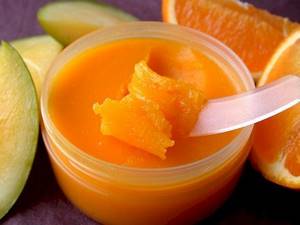
Mango butter has a semi-solid consistency, light yellow or cream color, and has a neutral aroma. Melts at a temperature of 40 degrees above zero. Mango butter contains monosaturated triglycerides (linoleic, linolenic, arachidic, oleic, stearic, palmitic acids), tocopherols, phytosterols, vitamins A, B, C, E, calcium, magnesium, iron, potassium, which have a positive effect on the condition of the skin. .
Properties of mango butter:
- accelerates tissue regeneration;
- slows down the aging process in dermal cells;
- moisturizes and softens the skin, relieves irritation;
- restores hair structure;
- relieves corns;
- removes age spots;
- strengthens nail plates;
- relieves muscle tension;
- gives hair shine;
- nourishes split ends and scalp;
- protects the dermis from ultraviolet radiation;
- relieves skin allergies.
In addition, mango butter is used to treat dry eczema, rashes, psoriasis, and dermatitis.
Exotic fruit seed oil is added to creams as an additional anti-aging, softening, moisturizing, analgesic, photoprotective, regenerating, anti-inflammatory component. In addition, it can be applied to the face and body in its pure form, as well as included in massage mixtures. Mango oil is left on the skin for 20 minutes, the residue is removed with a dry paper towel. Before use, the batter should be slightly melted in a water bath or in your hands (at 40 degrees Celsius).
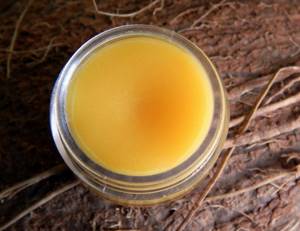
Lip nourishing balm
Ingredients:
- peach oil – 10 milliliters;
- beeswax – 10 grams;
- vitamin E (liquid) – 5 milliliters;
- mango butter – 10 milliliters.
Method of preparation: heat up, melt the wax, add mango butter, bring to a liquid state. Add the remaining ingredients into the resulting mixture, mix, and pour into an empty bottle. Let the balm harden. Apply the product to your lips in the morning, evening, as needed (if you feel dry).
Mango butter is stored in a tightly closed glass container in a cool, dark place for up to 2 years. Contraindications for use: individual intolerance.
Mango diet
It belongs to the category of fruit weight loss methods, it satisfies hunger well, and allows you to get rid of 2 - 3 extra kilograms in a week. Despite its low calorie content (65 calories per 100 grams of fruit pulp), it quickly saturates, “vitaminizes” the body, improves vision, strengthens the immune system, and improves the functioning of the gastrointestinal tract. For your diet, choose only ripe fruits. This way you will avoid stomach upset.
Allergy to the product and diabetes mellitus are two absolute contraindications to losing weight on the mango diet.
The duration of the course is a week. Every day the diet consists of the same foods.
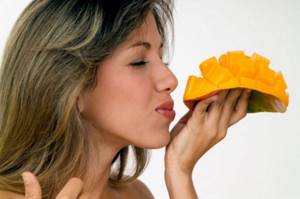
Menu for the week:
- breakfast - salad of one apple, half a grapefruit and mango, 200 milliliters of milk;
- lunch – two tomatoes, 200 grams of boiled chicken fillet, one mango, one orange;
- dinner - two mangoes, 200 grams of low-fat cottage cheese.
An hour and a half before bedtime, take 200 milliliters of kefir, 0% or 1% fat. Drink 3 liters of clean water throughout the day.
To eliminate one extra kilogram and cleanse the body of toxins, it is recommended to carry out mango fasting days once a week. During this period, it is allowed to eat only ripe fruits in unlimited quantities, drink freshly squeezed fruit juice, and water.
To eliminate 6–8 kilograms, the duration of the diet increases to 14 days. At the same time, the daily two-week diet consists of the following products:
Breakfast (choose 1 option):
- granola bar, one mango, one apple, black tea with lemon - 250 milliliters;
- oatmeal with water, without spices – 100 grams, one mango;
- fruit and vegetable salad of white cabbage, oranges, apples, seasoned with lemon juice - 200 grams, green tea - 250 milliliters;
- low-fat cheese (Tofu, Gaudette, Ricotta, Feta, feta cheese) - 50 grams, a slice of dried grain bread or toast, unsweetened coffee - 50 milliliters.
Lunch (choose 2 dishes, one of which contains mango):
- boiled beans – 100 grams;
- boiled beets – 50 grams, cabbage salad – 250 grams;
- cottage cheese casserole – 200 grams;
- white cabbage salad with mango, dressed with olive oil – 200 grams;
- vegetable soup – 350 milliliters, processed cheese – 10 grams;
- lean borscht (low-fat) – 300 milliliters;
- salad of oranges, apples, mangoes, cabbage – 200 grams;
- boiled fish (hake, pollock) – 150 grams.
Dinner (choose 2 dishes, one with mango):
- buckwheat porridge – 150 grams;
- kefir 1% – 200 milliliters, muesli – 150 grams;
- one boiled carrot, boiled legumes (beans, lentils, peas, beans) - 200 grams;
- cabbage salad – 150 grams, omelette from two chicken eggs;
- boiled fish – 100 grams;
- stewed cabbage with onions – 200 grams;
- one mango, green (herbal tea) – 250 milliliters;
- apple and mango salad – 200 grams.
Interestingly, the fruit stimulates the production of a hormone that suppresses appetite (leptin), so the mango diet is easily tolerated, without hunger pangs.
To diversify the menu, it is recommended to prepare fortified smoothies that burn fat. To do this, peel one orange and two kiwis and grind in a blender. Add 400 milliliters of mango juice to the citrus pulp, mix thoroughly, drink in small sips. This drink improves digestion, speeds up metabolism, triggers weight loss processes, strengthens the immune system, and removes toxins. To enhance the effect, add a pinch of red pepper, dry ginger, and cinnamon to the resulting cocktail. Don't combine mangoes with alcohol.
Composition of mango and its calorie content
It contains many useful substances, vitamins and minerals.
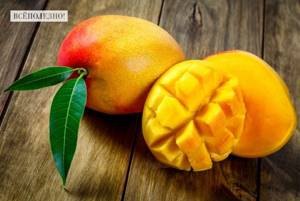
100 grams of fruit contains:
- 80 g water;
- 4 g protein;
- 15 g carbohydrates;
- 5 g fat;
- 4 g ash;
- 15 g fiber.
The main minerals contained in mangoes are sodium, calcium, potassium, zinc, iron, magnesium. In addition to vitamins and minerals, the fruit contains other beneficial substances, such as:
- polyphenols;
- flavonoids;
- starch;
- sucrose;
- organic acids.
An excellent property of the product is that it does not contain very many calories - approximately 67 kcal per 100 g of fruit.
What vitamins does it contain?
This fruit is rich in vitamins such as:
- Vitamin C or ascorbic acid – good for the immune system, nervous system, etc.
- Vitamin A – important for skin, vision, hair.
- Vitamin E – regeneration of damaged tissues.
- B vitamins – accumulation and restoration of human energy.
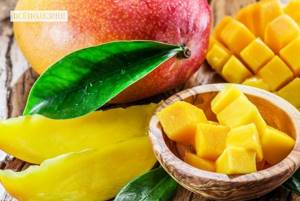
It is the record holder for the content of ascorbic acid (vitamin C), which is necessary for humans for normal growth and development.
Properties of the fruit
Mango, also called the Asian apple, has unique properties. For example, this is the only fruit that can stop cancer cells from dividing and infecting healthy tissues. However, it is not a panacea; it is used as an additional source of vitamins.
Benefit
The main benefit for the human body is due to the fact that it has a lot of antioxidants. These compounds fight the causes of most serious diseases.
Mango may have beneficial effects on:
- sugar level;
- blood pressure;
- brain;
- vision;
- bone health;
- heart and blood vessels;
- aging of the body;
- immunity;
- respiratory organs.
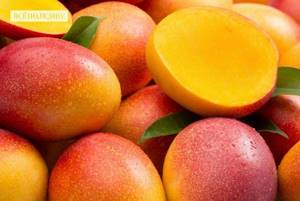
This is not all the benefits that this product can bring if it is eaten regularly.
For the immune system
This tropical product helps strengthen the immune system, as it contains a lot of vitamin C and zinc. According to research conducted in India, mango can reduce allergy symptoms and is an excellent defense against infections.
It should be eaten if there is vitamin deficiency, infectious pathologies of the teeth and oral cavity. The substances contained in the pulp can effectively eliminate the symptoms of colds, reduce fever, and help restore the body's defenses.
For the genitourinary system
In India, mango fruits are used as medicine. It is used by people suffering from pathologies of the urinary system and genital organs.
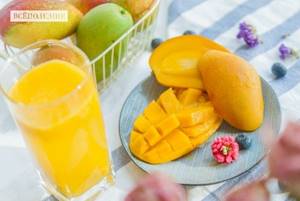
If you regularly include this product in your diet, you can reduce the risk of various kidney diseases. Substances contained in the pulp can prevent the occurrence of urolithiasis and kidney cancer.
For the nervous system
For the human nervous system, eating mangoes is also very beneficial. Its pulp contains a sufficient amount of B vitamins that can overcome constant fatigue and eliminate the effects of stress.
If you often include this product in your diet, then there is a chance to get rid of various nervous pathologies, put your emotional state in order, and increase sexual desire and sexual instinct. Mango can also reduce symptoms of toxicosis in pregnant women and improve their mood.
For the digestive tract
It contains a large amount of fiber, which has a beneficial effect on the digestive system. Unripe fruits are excellent for diarrhea, dysentery, constipation, hemorrhoids and other intestinal diseases. Pregnant women should eat mango to get rid of edema - the fruit helps get rid of excess bile and water.
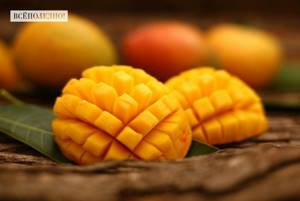
For vision
The pulp of the fruit contains a fairly large amount of retinol, which can strengthen the human optic nerve. It is also an excellent preventative against dry cornea, eye fatigue, and hemeralopia, better known as “night blindness.”
For the heart and blood vessels
Benefits of the fruit for the circulatory system and heart muscle:
- Increasing the elasticity of blood vessels.
- If you make a decoction of slightly dried leaves of the plant, you will get an excellent drug for lowering blood pressure. This decoction also helps to cope with varicose veins, pinpoint hemorrhages under the skin, etc.
- The large amount of iron in mango pulp helps if a person suffers from a lack of hemoglobin (anemia).
- Mango fruits strengthen heart tissue.
The pulp of the fruit contains substances that normalize the concentration of sugar in the blood. It is recommended to include it in the diet of people suffering from diabetes or atherosclerosis. Also, it is able to lower blood cholesterol levels and restore hormonal levels.
Possible harm and contraindications
Although mango has a large number of healing properties for the human body, there are also contraindications. Anyone who has never tried this product before should start with small portions to see if the fruit is well accepted by the body.
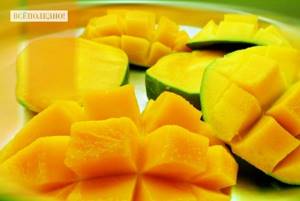
Important! Mango peel is considered one of the most potent allergens, so rubber gloves should be used when peeling the product.
Doctors recommend knowing several important rules when eating fruit:
- If everything is in order with your health, then unripe fruits should not be consumed, as they can provoke intestinal and stomach colic.
- If you get too carried away with eating mangoes, you can cause fever, constipation, and gastrostasis.
- Drinking alcohol in combination with mango is contraindicated, as it can cause serious food intoxication. The acids it contains have an irritating effect on the mucous membranes, and alcohol can provoke the inflammation process even more, which will lead to diarrhea.
- People suffering from obesity and diabetes should not consume candied mangoes, as they are quite high in calories and sugar.
Candied mango is a fruit that is first boiled in sugar syrup and then dried. They lose most of their valuable properties, so they are not considered useful products. If consumed frequently, they can cause diseases of the liver and digestive system.
Official medicine does not put forward specific prohibitions on eating mangoes, but to ensure that this fruit does not cause any harm to the human body, you need to make sure that the fruits are of high quality and follow several important rules when including them in your diet.
How to choose a mango
When buying, you should not pay much attention to its color - mangoes have many varieties, and accordingly, many different shades, from very dark to bright yellow. It is not possible to determine whether the fruit in front of your eyes is ripe or not by color.
You can tell how long a fruit has been sitting on the counter by looking at the condition of its skin - you need to buy fruits that have shiny, undamaged skin. The fruit itself should not be soft; it should seem that the skin is very stretched.
When purchasing, you should lightly press the fruit where the petiole was once attached and take a good sniff. A good, high-quality fruit has a sweet, rich, slightly resinous odor. If there is no bright aroma, then the fruit will not be tasty enough. If the aroma is sour, reeks of alcohol, then the product is stale.
Important! If you manage to buy unripe fruits, then there is no need to despair - if you put them in a warm place, first wrapped in paper or some kind of breathable fabric, then they will ripen calmly. Fresh mangoes cannot be stored in the refrigerator; they quickly become soft and lose most of their beneficial properties.
How to properly peel and eat mangoes
The fruit is very easy to clean, but you should use a few useful tips:
- If the fruit is ripe, the peel can be easily removed with a knife. To peel an unripe fruit, it will be convenient to use a potato peeler.
- You can peel it this way: first you need to carefully cut the fruit into two halves and remove the pit. Use a small knife to draw a grid on the resulting halves. According to the resulting pattern, cut the pulp without touching the peel. Then you need to turn the half out and carefully cut the resulting cubes from the peel.
- It’s even easier to peel the fruit with a spoon. You also need to use a knife to divide the fruit into two halves, then scoop out the pulp with a tablespoon.
- If the fruit is overripe, you need to make a cross-shaped cut at the top and pull the edge - the peel will easily separate from the pulp.
Removing the peel is easy, but removing the pit will be much more difficult. The easiest ways:
- Removal using a glass. To do this, you need to use a knife to divide the fruit in half, so that the entire bone remains in one of the halves. The side with the pit should be brought to the glass, the core should be lifted with the edge of the container and pressed gently. If you use this method, the bone will easily separate from the pulp and fall into the glass.
- Removal using a spoon. This method is suitable if the fruit is overripe or simply very juicy. You need to cut the fruit along the edge, then insert a spoon into the cut and carefully remove the seed with it.
- "The gimlet rule." This method is a little similar to the previous one, only in this case the fruit is cut crosswise rather than lengthwise. The upper half must be twisted, and the bone must be carefully removed from the lower half using a knife or spoon.
How to clean the fruit?
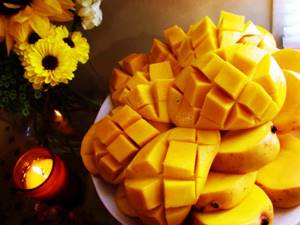
Place the mango on a plate and cut a piece from both sides as close to the bone as possible. Carefully “draw” a lattice pattern on the flesh of the cut piece with a sharp knife, without damaging the skin. Turn it inside out, you get something like a hedgehog. Cut each cube of pulp into a plate, and remove the skin from the rest of the piece and chop it.- Conditionally divide the fruit into 3 equal parts, make a shallow transverse cut at the level of 1/3, and cut the remaining 2/3 along the midline lengthwise. Then grab the mango by the corners of the skin and pull them, partially separating the pulp from the skin. Eat the peeled part, and then, holding the seed, remove the skin from the remaining third of the fruit.
- Peel the mango using a potato peeler or a regular sharp knife. This method is only suitable for cleaning unripe fruit.
How to cook it yourself?
You can make dried fruit yourself at home using a convection dryer for vegetables and fruits.
To prepare the product you need:
- Soak the mango fruit in soapy water, wash and rinse in running water to rid the fruit of dyes, preservatives and herbicides.
- Divide the fruit in half, remove bones and skin, remove any juice that appears with a paper napkin or towel.
- Cut the fruit halves into slices 20 mm thick and place them in the convector.

- It is important that there is free space between the pieces for air circulation. Mangoes should be dried for 13-14 hours at a temperature of 50°C.
You can also cook dried fruit in the oven. To do this, place the chopped mango on a baking sheet, previously covered with parchment, and dry at a temperature of 40°C for 6-10 hours. The oven door should be slightly open. Otherwise, the fruit will not dry, but will be baked.
How to eat mango?
- If you used the first method of peeling the fruit, the resulting pieces are eaten with a knife (according to the rules of etiquette), with a dessert fork, or pierced with skewers.
- The fruit can be eaten like an apple if it has been peeled using the second and third methods. However, in this case, be prepared for the fact that the juice may flow over your hands and clothes.
- The pulp of the ripe fruit can be ground in a blender, added to your favorite fruits and consumed as a puree.
- Very soft mangoes are eaten like kiwis. To do this, cut it in half without peeling it and eat it with a teaspoon.
As a rule, mangoes are consumed fresh. However, if desired, the fruits of the exotic tree can be canned, stewed, baked, added to salads, pizzas, smoothies, cocktails, ice cream, mousses, cakes, compotes, confitures, and sorbet. Mangoes are used to make jelly, jam, filling for pies and pancakes, marinades, sauces, and pickles. The fruit is baked with honey and cottage cheese like an apple. Lablab, a national Indian dish, is made from the young leaves of the mango tree.
It is recommended to eat up to 2 Asian apple fruits per day. In larger quantities, the fruit can be harmful to health: cause indigestion, colic, constipation.
Canned
Since the processed fruits of the exotic plant are no less tasty and healthy, the canned product, which is sold in light and concentrated syrup, is very popular among Russian consumers. In the first case, a minimal amount of sugar is used, which means the finished product looks healthier and healthier, especially when losing weight. Preservation in saturated sugar syrup is a fairly high-calorie and nutritious method, so it is not recommended to abuse the delicacy, especially if you have diabetes and are trying to lose weight. The average calorie content of canned mango is 73 kcal per 100 g.
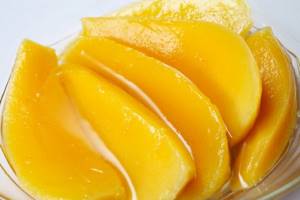
Canned Asian apple is suitable for use as an independent dessert and is very good as part of a variety of salads. It often acts as a flavoring additive and decoration in the preparation of mousses, jellies and sorbets. You can also prepare alcoholic and non-alcoholic cocktails using canned treats. Cooks even use the product to enhance the taste of fish and vegetables.
In addition to its high gastronomic qualities, canned pulp is famous for its many health benefits. It is recommended to use it for anemia, diarrhea and constipation, hemorrhoids, and a desire to cleanse the liver. Substances in the canned product help prevent vitamin deficiency and increase the elasticity of blood vessels.
Serving, etiquette
A whole, ripe mango is cut into four pieces, each of which is turned skin side up and held in place with a dessert fork. Then the pulp is separated from the shell, and the slices are cut into pieces. Mango is eaten with a fork. Before serving, remove the pit from the fruit. To do this, the fruit is first washed, then the seed is cut around the seed across the fibers, and the halves are turned in different directions. If the bone has grown to the pulp, it is cut out.
When setting the table, bowls of water are placed near the mango dish or lightly moistened napkins are placed to clean the fingers from the dyes concentrated in the pulp of the fruit.
To soften the oily taste, the fruit is served chilled.
What vitamins do mangoes contain?
The special vitamin composition allows you to enrich the entire body with useful substances. In mangoes, the chemical composition requires special attention when there is high acidity. The fruit contains a large amount of ascorbic acid. 100 g of product contains 178 mg of this substance.
The pulp contains a lot of natural fructose, carotenoids, and minerals. The vitamins in mango help strengthen the immune system, activate metabolic processes and cell restoration. The product contains the entire vitamin complex, folic and other organic acids, micro and macroelements. The pulp contains magnesium, copper, and zinc. Pantothenic acid is present in fruit fibers. It has a beneficial effect on the functioning of the central nervous system and enhances the transmission of nerve impulses. Mango is a natural antidepressant, which is especially appreciated by Asian peoples who revere this fruit.
Classic recipes with mango

Tropical panna cotta
Ingredients:
- heavy cream - 250 milliliters;
- water – 25 milliliters;
- mango - 1 piece;
- sugar – 50 grams;
- milk – 250 milliliters;
- leaf gelatin;
- vanilla;
- pistachios.
Cooking method:
- Peel the mango (using gloves), grind in a blender. Pour the finished puree into portioned bowls and place in the refrigerator to harden.
- Place leaf gelatin in cold water, following the proportions on the package. Add sugar, vanilla, cream into a heavy-bottomed saucepan, bring to a boil, stir until the crystals dissolve.
- Add milk, bring until smooth.
- Cool the cream mixture to room temperature, stirring occasionally to prevent foam from forming. After this, pour it into bowls on top of a layer of mango puree.
- Place the milk and fruit dessert in the refrigerator for 2 hours.
- When serving, garnish the panna cotta with ground pistachios and mango slices.
Mango salad with shrimp
Ingredients:
- cucumbers – 3 pieces;
- lettuce leaves - 10 pieces;
- mango - 1 piece;
- chopped dill – 20 grams;
- shrimp – 400 grams;
- grainy mustard – 45 grams;
- white wine vinegar - 30 milliliters;
- mayonnaise – 75 grams;
- sugar – 30 grams;
- salt;
- pepper.
Cooking principle:
- Boil, cool, peel the shrimp.
- Wash the cucumbers, peel the mangoes, cut into cubes.
- Combine sugar and vinegar, stir until completely dissolved. Add mustard and mayonnaise to the resulting sauce.
- Mix cucumbers, mangoes, shrimps, pour dressing.
Serve in portions on lettuce leaves.
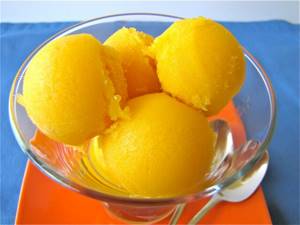
Mango sorbet
Ingredients:
- sugar – 120 grams;
- starch – 15 grams;
- mango – 2 pieces;
- water – 50 milliliters;
- juice of half a lemon;
- juice of one orange.
Cooking technology:
- Peel the mango, puree the fruit pulp, and place in the refrigerator.
- Mix citrus juice, add sugar, bring to a boil.
- Pre-stir the starch in water, pour into the orange-lemon syrup, heat until thick. Refrigerate.
- Mix mango puree with citrus mixture until smooth. Place in molds and place in refrigerator or ice cream maker to harden. Serve chilled.
Alcoholic cocktail “Mango daiquiri”
Ingredients:
- sugar syrup – 15 milliliters;
- lemon juice – 30 milliliters;
- mango – 0.5 pieces;
- ice – 50 grams;
- rum – 50 milliliters;
- mango juice – 30 milliliters.
Cooking method:
- Peel the mango.
- Beat the fruit pulp and remaining ingredients in a blender.
- Serve the resulting cocktail in a Margarita glass.
Use in cooking
The fruit can not only be consumed, but added to various dishes. It is used for making sauces, salads, baked goods, jams, desserts, stewing and baking meat and fish.
With beef meat
To prepare the dish you will need:
- beef tenderloin – 500 g;
- dried mango – 300 g;
- carrots – 1 pc.;
- sweet potato – 2 pcs.;
- green beans – 200 g;
- boiled water – 1/2 cup;
- soy sauce – 2-3 tbsp. l;
- cognac – 2 tbsp. l.;
- chili pepper – 1/2 pcs.
Step-by-step instruction:
- First you need to wash the tenderloin, dry it with a paper towel and cut it into thin pieces. Afterwards the meat needs to be beaten a little.
- Next, wash the vegetables, peel and chop thinly, and fry the chopped meat in a frying pan greased with vegetable oil for 3 minutes.
- Then you need to add carrots to the meat and fry again. After 3 min. You can pour water into the pan, add sweet potato, beans and 5 pieces of mango. All this needs to be simmered for 30 minutes. Afterwards you will need to pepper the dish and evaporate the water.
- Now you can prepare the sauce by pouring 1/2 tbsp mango. boiled water and beat with a blender. The resulting mass should be heated in a frying pan, chili pepper and cognac should be added to it, and then the sauce should be simmered for 15 minutes.
- The finished dish should be topped with mango sauce.
With chicken breast
Required ingredients:
- 200 dried mangoes;
- 1 bell pepper;
- 200 g chicken breast;
- 4 tbsp. l. lime juice;
- 1 onion;
- 1 cucumber;
- 1 tsp. granulated sugar;
- a few mint leaves.
Cooking process:
- First you need to boil the chicken breast, and then cut it into cubes.
- Then you should cut the bell pepper, mango, onion, mint leaves into medium-sized pieces and place in a deep plate.
- Then you need to add chopped chicken breast, lime juice and sugar to the ingredients.
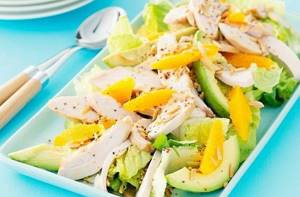
- Now you can thoroughly mix the salad.
Dried mango is easy to make at home. It will be more useful and less harmful to the body.
With shrimps
The dish consists of the following components:
- 200 g dried mango;
- 1 avocado;
- 150 g frozen shrimp;
- 1 liter of water;
- 5 g salt;
- 150 g arugula;
- 1 red onion;
- salt, pepper as desired.
Step-by-step scheme:
- First, defrost the shrimp, rinse and remove the shell.
- Then you need to pour water into the pan, add salt, put it on the fire and wait until it boils.
- Then you need to put the shrimp in boiling water and cook for 10 minutes. Boiled shrimp should be placed in a colander to rid them of excess water.
- Next, you need to cut the avocado, red onion and mango into medium-sized pieces. Afterwards you need to chop the shrimp and arugula.
- Now you can add salt, pepper and mix the salad.
With fish
To prepare the dish you will need:
- 400 g fish fillet;
- 4 tbsp. l. olive oil;
- 1 onion;
- 300 g dried mango;
- 3 tbsp. l. granulated sugar;
- 1/2 can of canned pineapple;
- 1/4 tbsp. red semi-dry wine;
- salt, pepper to taste.
Step-by-step instruction:
- The first step is to wash the fish, brush with salt and pepper on each side and heat a frying pan with olive oil.
- Next, fry the fish in olive oil for 4 minutes. at both sides.
- Then you need to heat the olive oil again over medium heat, finely chop the onion, and then fry until soft.
- Then you need to add granulated sugar to the onion, mix and cook until the sugar is completely dissolved. This will take no more than 1 minute.
- Now you can cut the pineapple and mango into cubes and add them to the pan along with the wine. The mixture must be boiled for 5 minutes. over low heat.

- Before serving, the fish must be poured with warm sauce.
Chicken stew
Required ingredients:
- chicken thighs – 800 g;
- dried mango – 200 g;
- canned beans – 400 g;
- green peas – 1/2 cup;
- white wine – 100 ml;
- chili pepper – 1/2 pcs.;
- salt, vegetable oil to taste.
Step-by-step instruction:
- First you need to rinse, peel the meat and cut into small pieces.
- Then pour oil into the pan and fry the chicken until golden brown.
- Next you need to add wine, pepper and simmer the meat for 25 minutes. over low heat.
- Then you need to cut the mango and add it to the chicken. You also need to put beans and salt in there and simmer again for 5 minutes.
